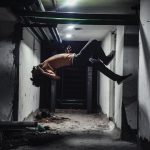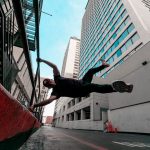Download links
How to install Mastering the Art of Parkour with taya773 APK?
1. Tap the downloaded Mastering the Art of Parkour with taya773 APK file.
2. Touch install.
3. Follow the steps on the screen.
Description
Parkour, often described as the art of movement, is a discipline that emphasizes fluidity, efficiency, and creativity in navigating obstacles in one’s environment. Originating in France in the late 20th century, parkour was developed by David Belle and his peers, who sought to create a physical expression of overcoming challenges. The practice involves running, jumping, climbing, and vaulting over various structures, such as walls, railings, and rooftops.
Unlike traditional sports that often have rigid rules and competitive elements, parkour is more about personal expression and self-improvement. It encourages practitioners to adapt their movements to their surroundings, fostering a unique relationship between the individual and the environment. The philosophy behind parkour extends beyond mere physicality; it embodies a mindset of resilience and determination.
Practitioners, known as traceurs (male) or traceuses (female), often emphasize the importance of mental fortitude alongside physical prowess. Parkour is not just about executing impressive stunts; it’s about cultivating a sense of confidence and self-awareness. This discipline encourages individuals to confront their fears and push their limits, both physically and mentally.
As a result, parkour has gained popularity worldwide, transcending its origins to become a global movement that inspires countless enthusiasts to explore their capabilities.
Key Takeaways
- Parkour is a physical discipline that involves moving through obstacles in a fluid and efficient manner, often in urban environments.
- Practicing parkour can improve strength, agility, balance, and mental focus, while also providing a sense of freedom and creativity.
- Taya773’s journey in parkour has been one of self-discovery, overcoming fears, and pushing personal boundaries.
- To master parkour, it’s important to focus on developing strength, flexibility, and spatial awareness, as well as learning proper landing and rolling techniques.
- Safety precautions for parkour training include warming up, using proper equipment, practicing on safe surfaces, and knowing one’s limits to avoid injury.
The Benefits of Practicing Parkour
Engaging in parkour offers a multitude of benefits that extend beyond physical fitness. One of the most significant advantages is the improvement of overall physical health. Parkour training involves a variety of movements that enhance strength, agility, balance, and coordination.
The dynamic nature of the discipline requires practitioners to engage multiple muscle groups simultaneously, leading to increased muscle tone and cardiovascular endurance. For instance, the explosive movements involved in vaulting over obstacles can significantly boost anaerobic capacity, while the continuous flow of movement enhances aerobic fitness. Moreover, parkour fosters mental resilience and problem-solving skills.
As practitioners navigate complex environments, they must constantly assess their surroundings and make quick decisions about how to approach obstacles. This cognitive engagement sharpens focus and enhances spatial awareness. Additionally, overcoming physical challenges can lead to increased self-esteem and confidence.
Many traceurs report a profound sense of accomplishment after successfully executing a difficult move or conquering a daunting obstacle. This boost in self-confidence often translates into other areas of life, encouraging individuals to tackle challenges with a more positive mindset.
Taya773’s Journey in Parkour

Taya773, an emerging figure in the parkour community, exemplifies the transformative power of this discipline. Starting her journey at a young age, Taya was initially drawn to parkour through social media platforms where she discovered videos showcasing incredible feats of agility and creativity. Inspired by these visuals, she began practicing in her local environment, using urban landscapes as her playground.
Taya’s early experiences were marked by trial and error; she faced numerous falls and setbacks but remained undeterred in her pursuit of mastery. As Taya progressed in her training, she began to document her journey online, sharing her successes and challenges with a growing audience. Her authenticity resonated with many aspiring traceurs who found motivation in her story.
Taya773’s commitment to continuous improvement led her to seek out workshops and training camps where she could learn from experienced practitioners. Through these experiences, she not only honed her skills but also built a supportive community around her. Taya’s journey illustrates how parkour can serve as a catalyst for personal growth, fostering connections with others who share similar passions.
Tips and Techniques for Mastering Parkour
| Technique | Description |
|---|---|
| Precision Jump | A jump that requires accuracy and control to land on a specific target. |
| Wall Run | Running up a vertical wall using momentum and foot placement. |
| Roll | A technique to absorb impact and maintain momentum after a jump or fall. |
| Cat Leap | A dynamic jump where the athlete grabs onto a ledge or wall with their hands. |
| Underbar | Passing under an obstacle by swinging the legs through and landing on the other side. |
Mastering parkour requires dedication and a strategic approach to training. One essential tip for aspiring traceurs is to start with foundational movements before progressing to more complex techniques. Basic skills such as rolls, jumps, and landings form the building blocks of parkour.
Practicing these movements repeatedly helps develop muscle memory and ensures safety when attempting more advanced maneuvers. For example, mastering the forward roll not only aids in absorbing impact but also serves as a transition between movements. Another crucial aspect of parkour training is understanding body mechanics and movement efficiency.
Practitioners should focus on maintaining proper form during jumps and landings to minimize the risk of injury. Engaging the core muscles while executing movements can enhance stability and control. Additionally, incorporating strength training exercises into one’s routine can significantly improve performance.
Exercises such as squats, lunges, and plyometric drills build the necessary strength for explosive movements like vaults and precision jumps. By combining strength training with skill practice, traceurs can develop a well-rounded approach to mastering parkour.
Safety Precautions for Parkour Training
While parkour is an exhilarating discipline that promotes physical fitness and mental resilience, it also carries inherent risks. Therefore, safety precautions are paramount for anyone looking to practice parkour effectively. One of the most critical safety measures is to train in appropriate environments.
Beginners should start in controlled settings such as parks or gym facilities designed for parkour training. These spaces often feature padded surfaces and obstacles that allow for safe practice without the dangers associated with urban environments. Additionally, wearing suitable gear can significantly reduce the risk of injury during training sessions.
Shoes with good grip and cushioning can help prevent slips and provide adequate support during jumps and landings. Furthermore, it’s advisable to train with a partner or in groups whenever possible.
Having someone nearby can provide encouragement and assistance in case of falls or injuries.
Taking Your Parkour Skills to the Next Level

Goal-Oriented Practice
This goal-oriented approach not only provides motivation but also encourages focused practice sessions that yield tangible results. By setting specific goals, practitioners can track their progress and stay motivated to continue improving.
Exploring Different Styles and Techniques
Exploring different styles within parkour can enhance one’s skill set. Many practitioners find inspiration in disciplines such as freerunning or tricking, which incorporate acrobatic elements into traditional parkour movements. By experimenting with flips or spins, traceurs can expand their repertoire while developing greater body control and spatial awareness.
Continuous Learning and Improvement
Participating in workshops or training camps led by experienced instructors can also provide valuable insights into advanced techniques and strategies for improvement. Ultimately, taking parkour skills to the next level involves embracing challenges and remaining open to learning from both successes and failures. The journey is as much about personal growth as it is about physical achievement; each leap over an obstacle represents not just a physical feat but also a testament to one’s determination and resilience in the face of adversity.
FAQs
What is parkour?
Parkour is a physical discipline that involves moving through an environment in a creative and efficient way, using only the human body and the surroundings to propel oneself.
Where did parkour originate?
Parkour originated in France, developed by David Belle and his group of friends in the late 1980s. It was inspired by military obstacle course training and various physical disciplines.
What are the basic movements in parkour?
Basic movements in parkour include running, jumping, climbing, vaulting, and balancing. These movements are used to navigate obstacles and terrain in a fluid and efficient manner.
Is parkour dangerous?
Parkour can be dangerous if not practiced with proper training and caution. It involves high levels of physical exertion and risk of injury, so it is important to learn from experienced practitioners and progress at a safe pace.
Can anyone do parkour?
Parkour is accessible to people of all ages and fitness levels, but it requires dedication, discipline, and proper training to develop the necessary skills and strength. It is important to start with the basics and progress gradually to avoid injury.
Where can I learn parkour?
There are many parkour gyms and training facilities around the world where you can learn parkour from experienced instructors. Additionally, there are online resources and tutorials available for those who prefer to learn on their own.





